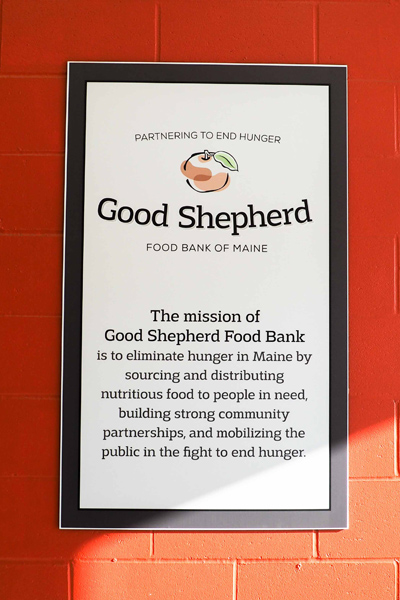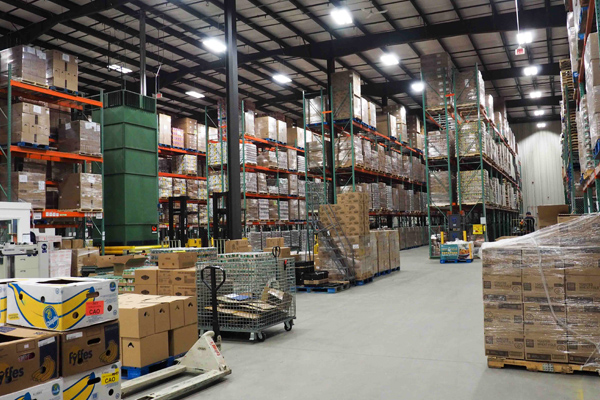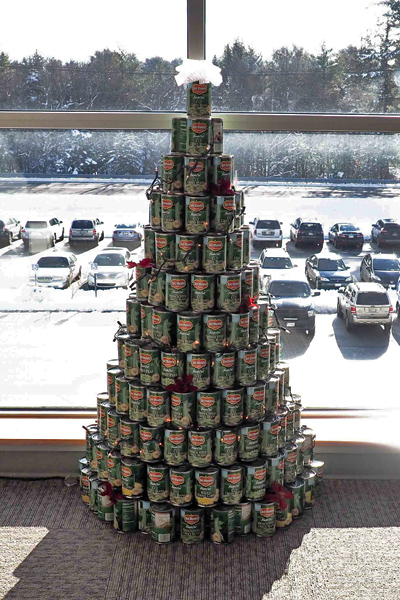22 Dec Good Shepherd Food Bank
Every year, Clark Insurance enters the Holiday Season with our end-of-year giving. We support many valued organizations, notably ones that cater to the causes of food insecurity, clothing, shelter, higher education and wellness. In addition to our philanthropic support we also feature one end of year giving recipient through conducting an interview, capturing their mission, accomplishments and goals – to share with our community. This year, James Brissenden, our Marketing and Communications Specialist, sat down with Good Shepherd Food Bank. See below for the story!
I walk into the entry-way of Good Shepherd Food Bank – at their Auburn Distribution Center. To my right is a big sign hung from a bright red painted brick wall. The message reads:
Good Shepherd Food Bank
“The mission of Good Shepherd Food Bank is to eliminate hunger in Maine by sourcing and distributing nutritious food to people in need, building strong community partnerships, and mobilizing the public in the fight to end hunger.”
Undoubtedly Impressive! But how does an organization achieve such a sizeable goal of eliminating hunger in Maine? One floor above, in a newly renovated office space, I sit down with Erin Peck Yarema, the Major Gift Officer for Good Shepherd, and Ben Sullivan, in the marketing and communications department. Pen at the ready, I listen on as we look at the highlights of Good Shepherd Food Bank in 2017 and what is to come in 2018. It is in this conversation that we find an answer to just how Good Shepherd Food Bank plans on ending hunger in the state of Maine.
Highlights of 2017
Erin begins: “2017 was defined by a shift in focus of our existing Mainers Feeding Mainers Program.” That shift, she later explains, was a focus on not just distributing food, but distributing healthy food. She gives some context: “The program started in 2009. It is a food-distribution network that connects local farmers with those in need in their respective communities.”
Ben adds: “It’s a special program. You don’t realize just how meaningful it is – not only for the clients receiving the food but also for the farmers handing it out.”
He explains that when one often receives help in the form of second-hand donations, food or otherwise, to be given food grown specifically for you is empowering. And, on the giving end are the farmers, who consistently report back how shocked they are at the sheer volume of those in need in their own communities. And they’re unfortunately right: 16.2% of Maine households (more than 208,000 Mainers) are food insecure, meaning they lack access to enough nutritious food to live a healthy life.
Thus presented the shift for Good Shepherd Food Bank. “They key,” Erin says, “is fresh produce.” And what sounds simple at first, demands investments in time, money, and particularly infrastructure. In comes 2018.
What is to Come in 2018
“Most food banks are focused on non-perishable items which, unfortunately, tend to be less healthy,” Erin explains. “Now that so many people are reliant on us as a consistent source of food we need to be mindful of promoting healthy eating.”
To do that, I learn, requires two main components: the infrastructure to store fresh produce, and the help of 400+ of their agency partners in distributing that food to the hands of those in need.
First, comes the infrastructure. “Storing fresh produce,” Ben starts, “requires many industrial sized fridges. Ideally you have multiple fridges set at varying temperatures depending on the produce inside – all set to maximize the shelf life of your food. This is exactly what we are going to do with our new distribution center.”
Good Shepherd Food Bank is adding another distribution center in Hampden: a 5 million dollar project breaking ground in early summer of 2018. At 1.5 million cubic feet, this distribution center is going to house even more industrial fridges – not just for the needs of their own produce, but also to be used by neighboring farms to store any overstock a season might bring. With the infrastructure to house the produce, they then set their sights on strengthening their agencies and distribution networks.
“We are in the process of doing a needs assessment of all our agency partners,” Erin says. “We simply cannot be successful and get our food in the hands of the hungry without the help of these distribution networks, especially with perishable items. We’re asking what are the barriers, challenges, opportunities? What more can be done to help them? There are some communities that don’t even have a foodbank, and we can help them start one.”
At this point in the interview, I realize the scope of what Good Shepherd is accomplishing. Take a look at this metric: In 2012, Good Shepherd Food Bank distributed almost 13 million pounds of food in the calendar year. In 2017: almost 32 million. I realize; though, that with an understanding of the successes and sheer size of the organization comes a realization that there must exist an equally large, if not larger, problem. And that problem is food insecurity in the state of Maine.
How YOU Can Make an Impact
Naturally, we transition to what YOU can do to assist Good Shepherd Food Bank in ending hunger in Maine. First, volunteer at a distribution center! But take note – there is such a burst in effort over the Holiday season, that the months of January and February actually experience a shortage of volunteers. If you’re considering lending a helping hand, why not extend the season of giving further into 2018?
Second, I was shocked to hear just how far a dollar will go in the hands of Good Shepherd. In lieu of whole stock prices, a donated dollar equates to 4 full meals for the hungry. Donations of canned goods and other food are always welcomed, but next time you’re purchasing a can of beans, remember that a monetary donation can have up to four times the impact. Food for thought.
Papers packed and coats on, we shake hands as I walk down the stairs, passed the cans of green beans organized in the shape of a Christmas tree, and back down to the lobby, where I first read the mission statement sign. I walk back out of their Auburn distribution center with a greater appreciation of the magnitude of food insecurity in Maine, a greater understanding of the ways Good Shepherd Food Bank is combating it, and how exactly I can help. A morning well spent.
Here is a link to donate to their cause. We hope you join Clark in helping Good Shepherd Food Bank end hunger in Maine!






